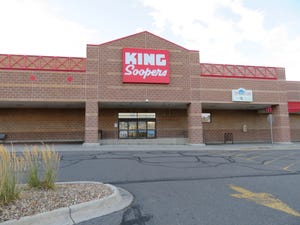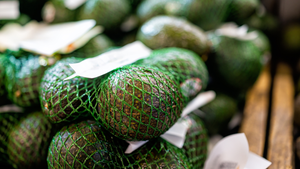PRECUT FRUIT'S DICEY OUTLOOKPRECUT FRUIT'S DICEY OUTLOOK
Fruit is lagging behind vegetables in the fresh-cut marathon in the supermarket produce department. As retailers rush to expand their selections of salad mixes and precut vegetables to capitalize on the growing demand for convenience items, they are not going the distance with precut fruit. At least not yet.Fruit cut up into slices and pieces can be profitable, retailers said, and many are choosing
May 2, 1994
TONY SPLEEN
Fruit is lagging behind vegetables in the fresh-cut marathon in the supermarket produce department. As retailers rush to expand their selections of salad mixes and precut vegetables to capitalize on the growing demand for convenience items, they are not going the distance with precut fruit. At least not yet.
Fruit cut up into slices and pieces can be profitable, retailers said, and many are choosing to maintain their programs, which have price tags of 10% to 20% more than whole fruit. But few are trying to expand their precut selection right now, and some are even looking at dropping the category due to poor sales.
What's tripping it up?
Industry executives interviewed by SN said growth is being slowed by the short shelf life of fruit items compared with that of precut vegetables and salad mixes. Fresh fruit can be maintained for only a few days, while prepacked salad mixes can last in the case for up to two weeks.
There are also high labor costs involved, since most fruit today needs to be processed at store level, a fact that brings with it food safety and sanitation concerns, and potential inconsistencies in taste and quality. The bulk of vegetable and salad items featured in the growing number of convenience sections in produce departments is brought into stores prepacked by suppliers. All a produce clerk needs to do is unpack the boxes and put the product on display. For fruit, the technology isn't there yet -- although efforts are well under way to develop it -- to allow it to be safely processed at an outside facility and brought into stores. Most cut fruit has a three-day shelf life at best, according to industry sources, and it deteriorates rapidly when held at temperatures above 38 degrees -- two reasons why it isn't a good candidate for distribution channels that too often are compromised by delays and temperature fluctuations.
"It's a very big challenge," said Tom Gallahan, vice president of produce and floral for Grand Union Co., Wayne, N.J. "They would have to assure me that it's fresh and that it could handle different temperature zones during distribution."
Like many programs that require extra labor in the supermarket perishables departments, fresh-cut fruit can be a star, but only if the company makes a major investment and commitment to the program, retailers said. The payoff is excellent margins, despite accounting for a relatively small percentage of sales -- around 1%, compared with 8% for precut vegetables and salad mixes, according to industry estimates.
Grand Union offers 45 different fresh-cut fruit items, ranging from melon slices, halves, quarters and cubes to decorated fruit bowls and mixed fruit cups. All items are cut and packaged in-store, which allows the retailer to control temperatures and the amount of the product put out on display.
Grand Union's stores have between 12 and 16 feet of refrigerated ice cases for displaying fresh-cut fruit. New stores are allocating 22 feet of cases for fresh cuts.
Gallahan said refrigerated ice cases are the only way to go.
"We used to use just ice tables," he said. "Now we use refrigeration and ice. The key to shelf life is proper temperature control."
Roger Schroeder, vice president of produce for Hughes Family Markets, Irwindale, Calif., said he would bring in precut fruit from an outside processor if the product had a shelf life of six to eight days.
Until then, Schroeder is concentrating on melon wedges and chunks, which are prepared at store level. "We have a tremendous opportunity with cut up fruit, but it still has a short shelf life and it's very labor-intensive,"he said.
"I don't know of any technology that prevents fruit from deteriorating,"said Jose Manzano, produce director for Dorothy Lane Market, a two-store independent in Dayton, Ohio. "Fruit has to be done at store level. Vegetables are more durable than fruit and can be packed" at the source.
In addition to offering fresh-cut fruit in the stores' salad bars, Manzano handles a small amount in his two produce departments. He offers a limited selection, including cut melons with berries and trays of mixed fruit prepared daily -- the most popular fresh-cut item. About 2 pounds of cut melons and berries are arranged in rows on a black tray and overwrapped with film. Each store sells about 36 trays a day for $2.89 per pound.
"There's definitely a demand from our customers, but I don't see much growth in the category," Manzano said. "We have peaked to a point." If technology were developed to extend shelf life, and if processors began packing more fresh-cut fruit, Manzano said he might get more involved.
"I don't know how any processor will be able to do a source pack," said Vince Terry, director of produce operations for Harp's Food Stores, a 28-store chain based in Springdale, Ark. "The technology just isn't there yet to extend shelf life. But we're looking forward to trying it once it gets there."
Terry added that even if technology improves, processors will need to assure him that their products can maintain integrity and flavor as well as save labor at his end. "Consistency will remain a very important issue," he said.
Processors will also need to guarantee five to seven days' shelf life once the product reaches stores, Terry said, and they will "need to guarantee that the cold chain isn't broken during distribution. Fruit is much more sensitive than vegetables."
Harp's value-added fruit and fresh-squeezed juice program includes about 30 different items. All products are prepared in-store, within full view of customers. The more popular items include a fresh-cut melon salad and a fresh-cut fruit salad, both of which
sell for $1.19 a pound. Also very popular is a 2-pound container of mixed berries with a sweet cream cheese dip, selling for about $10.
Terry attributes the success of his program to the fact that it's done at store level. Customers gain confidence when they see the preparation of the product and when employees are available to answer questions, he said. He predicts continued growth for his program.
But not all retailers are having such success with fresh-cut fruit, nor do they anticipate much of a change even if processors can improve shelf life and provide high-quality products.
"We haven't made a commitment to it," said Tim Culhane, store manager at Brennan's Country Farm Market, Monroe, Wis. Culhane manages the Brookfield, Wis., store, one of four operated by the independent, which specializes in perishables -- about half produce.
Despite the fact that Brookfield is an upper-class suburb of Milwaukee and customers tend to be from two-income households, customers aren't looking for convenience items, Culhane said. "We have found that they like to cut up their own fruit."
Lee Reynolds, produce merchandiser for Haggen Inc.'s TOP Food and Drug chain, Bellingham, Wash., echoes Culhane's sentiments. "I've tried it in our market and our customers just aren't attuned to it," said Reynolds, who is responsible for the company's 12 stores in the Seattle area. "Even in our best stores where you would think customers would want it, it just doesn't sell." Although he does sell some cut and wrapped watermelon, cantaloupe and honeydew, "90% of our customers are going to buy whole melon," he said.
The primary reasons Reynolds cites for his customer's lack of interest in precuts are taste and price. "During certain times of the year, melons just don't taste good, and as a result, customers are going to ask, 'Are fresh cuts worth the higher cost?' "
It's not that his customers aren't interested in value-added, convenience items, he said. "Precut vegetable sales have been wonderful," he said. "Melons tend to be inconsistent in pricing and quality throughout the year. Cut vegetables, on the other hand, run fairly stable."
Regardless of their level of success with fresh-cut fruit, retailers interviewed by SN all agreed that in addition to shelf life, two other challenges come along with the category: sanitation and labor.
"It's an area I look at all the time as having great potential," said Fred Mooney, director of produce buying and merchandising for Andronico's Park and Shop, a five-store independent based in Albany, Calif. "We draw the line because of health standards. It's a great area because it has a lot of value, but it's a scary area because of the potential liability."
Retailers involved in fresh-cut fruit must follow strict sanitation regulations, which vary by state. Fruit can carry harmful bacteria. For example, the rinds of some melons -- like cantaloupes -- can carry foodborne pathogens that can cause salmonella.
Mooney's fears haven't kept him out of the category altogether, however. With the exception of his fresh-squeezed juice bar and a variety of cut melons, he has turned over other precut fruit items to the deli. "We take sanitation very seriously," he said. "Our deli department already has systems in place to comply with health standards and codes."
Grand Union's Gallahan said that in his new stores, separate rooms are being added that will be designated for salad bar and fresh-cut fruit preparation. Keeping the operation confined to one area will help ensure compliance with sanitation standards, he said.
Like most programs executed at store level, fresh-cut fruit requires a significant investment in labor. Whether or not retailers make the investment depends on the return they hope to achieve.
"We're a service-oriented company," said Brennan's Culhane. "I want our employees out helping customers, not in the back cutting up fruit."
"I had a really hard time justifying the amount of labor when I considered the return," said Reynolds of Top Food and Drug. "I'm amazed that other retailers can justify the expense."
But that's exactly what many other retailers say they can do.
"When you're selling something for $2.99 a pound, you can afford to have some labor," said Grand Union's Gallahan.
"Our fresh-cut fruit and juice category is growing one-and-a-half times the rate of normal store growth, because it's such a high-profile item," said Harp's Terry.
"We've always had to put up with the labor challenge in other service departments," said Dorothy Lane's Manzano. "The sales we've gained justify the labor. So far we've been able to enjoy better profits. Labor is just one more challenge to get over."
About the Author
You May Also Like




